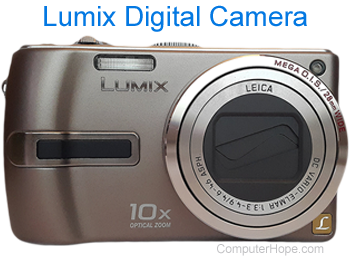Digital camera

A digital camera is a hardware device that takes photographs and stores the image as data on a memory card. Unlike an analog camera, which exposes film chemicals to light, a digital camera uses digital optical components to register the intensity and color of light, and converts it into pixel data. Many digital cameras are capable of recording video in addition to taking photos. The picture is of a Lumix digital camera from Panasonic.
A camera that is always connected to your computer with no storage could also be called a digital camera. However, it's more appropriate to refer to this device as a webcam.
A digital camera may be considered both an input and output device (I/O device) as it can both take pictures (input) and send them to your computer (output).
Digital camera was featured as a top term of 1999.
What are the advantages of using a digital camera?
Below are key advantages that make digital cameras a popular choice compared to film cameras.
LCD screen
The rear-mounted LCD (liquid-crystal display) screen on a digital camera allows users to see their photos and videos immediately after they are taken. The LCD screen can also make it easier to frame your pictures.
Storage
A digital camera can store thousands of pictures, instead of only up to 36 pictures.
Picture development
Digital camera pictures can be developed like a standard film camera, but you can pick which pictures to develop instead of developing the whole roll of film.
Size
Because a digital camera does not need a place for film, it takes up far less space and can easily be carried in your pocket or purse.
Digital camera picture quality
The quality of pictures that a digital camera can take is primarily based on its megapixel rating. The higher the megapixels, the better the picture quality. For example, a 10 MP (megapixel) digital camera takes better pictures than a 7-megapixel digital camera.
Other factors that affect picture quality include the type of camera lens, size of the lens (measured in millimeters), and type of camera itself. Lower cost digital cameras often feature a lower quality and standard size lens and provide minimal zoom capability. Higher priced, higher quality digital cameras include a better quality lens, possibly a larger size lens, and feature increased zoom capabilities.
Some digital cameras, like a digital SLR camera, allow users to adjust lighting, aperture, shutter speed, and other settings, providing improved control over picture quality. These digital cameras also allow for accessory attachments to increase or decrease the size of a lens and length of zoom.
History of the digital camera
Although the idea for a digital camera originated in 1961, the technology to create one didn't exist. The first digital camera was invented in 1975 by Steven Sasson, an engineer at Eastman Kodak. It primarily used a charge coupled device, a type of image sensor, but originally used a camera tube for image capture. That functionality was later digitized by Kodak. The first digital cameras were used by the military and for scientific purposes. Medical businesses and News reporting companies began to use digital cameras a few years later.
Digital cameras did not become common consumer electronic devices until the mid-1990s. By the mid-2000s, digital cameras mostly replaced film cameras as the camera of choice by consumers.
Camera, DCIM, Digital, Digital camcorder, Hardware terms, Image, Memory card, Peripheral, Photo, Redeye, Telephoto, Video, Viewfinder, Webcam
